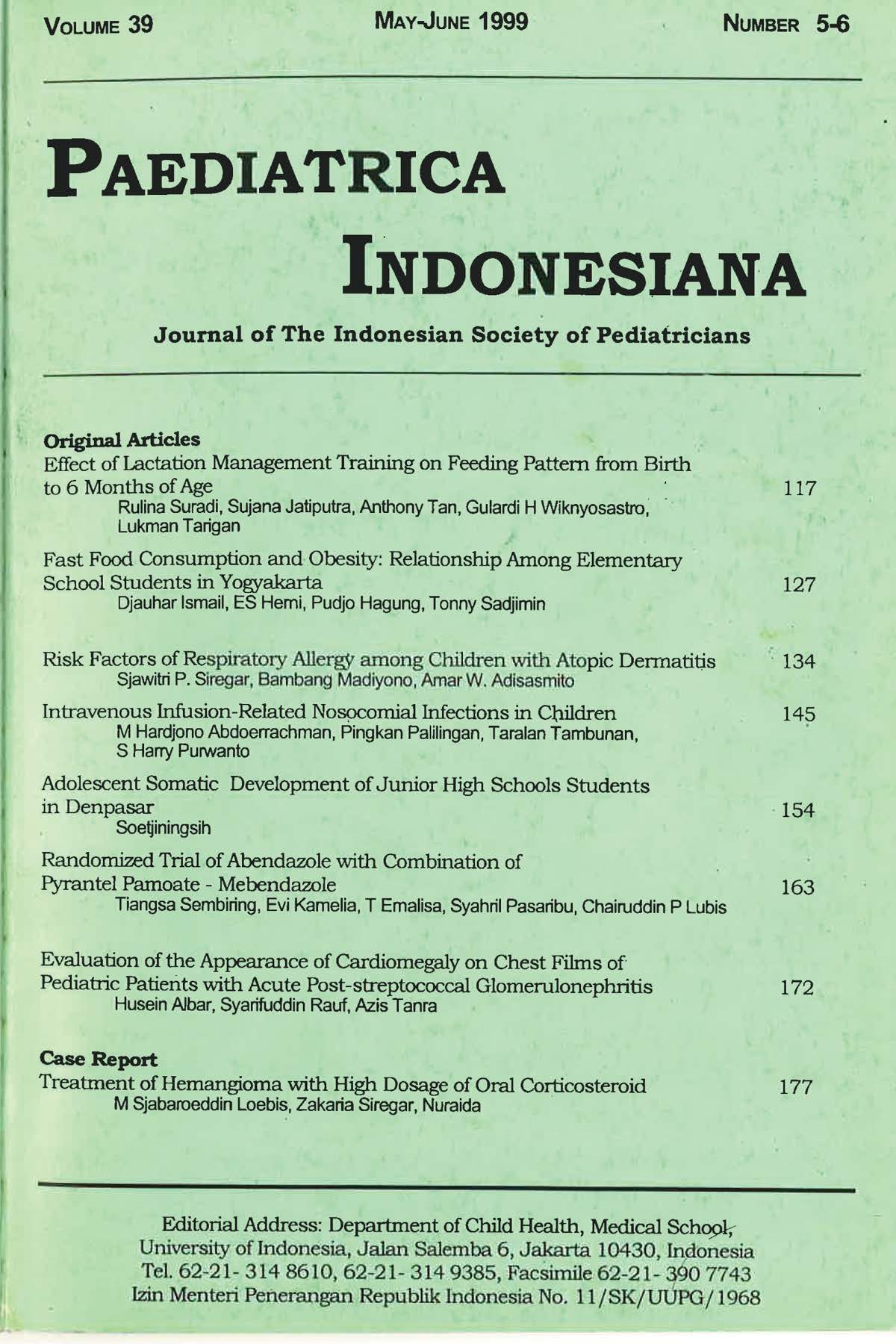Intravenous infusion-related nosocomial infections in children
DOI:
https://doi.org/10.14238/pi39.5-6.1999.145-53Keywords:
intravenous infusion-related, nosocomial infectionAbstract
A prospective study was conducted ID obtain the basic data of intravenous infusion-related nosocomial infections at the Pediatric Department Child Health, Cipto Mangunkusumo Hospital in Jakarta during the period of March - May 1998. Subjects were patients with a single intravenous infusion without any other invasive measures. All patients were admitted at the intermediate and ordinary ward that was classify tothe First and Second Class, Third Class according to room rate and number of beds. From 62 patients with intravenous infusion, 21 were infected (33. 9% with 95%CI; 0.226; 0.471). Complications of intravenous infusions were skin infdtrations (17 /62), phlebitis (8/62), bacteremia (4/62), and septicemia (1/62). The most frequently found
microorganism were Staphyloroccus epidermidis, Enterobacter aerogenes, Acinobacter calroaceticus, Serratia marcescens, Pseudomonas aeruginosa and Staphylococcus aureus. The results of the senstivity tests of those microorganisms proved that all bacteriac, Gram positive as well as Gram negative were sensitive to the following
antibiotics (in decreasing order): cypronoxacine, amikacin, gentamicin, cefphyrome and ceftriaxon. Gram positive bacteriae were also sensitive to vancomycin and cephalotin.
References
2. Abdoerrachman MH, Tumbelaka AR. Upaya pengendalian infeksi nosokomial di Bagian llmu Kesehatan Anak FKUl/RSCM. Majalah Kedokteran Indonesia, 1998; 48:213-8.
3. Maki DG, Boticelli JT. Prospective study of replacing administration sets of intravenous therapy of 48 vs 72 hour interval. Jama 1987; 258:1777-81.
4. Widmer AF. Intravenous related infections. In: Wenzel RP, ed. Prevention and control of nosocomial infections,3rd edition. Baltimore: Williams & Wilkins, 1997; 771-96.
5. Maki DG. Lnfections due to infusion therapy. In: Pennet JV, Brachman PS, ed. Hospital infections,3rd edition. Boston: Little Brown and Company, 1992; 849-90.
6. Castle M, Ajemian E. Nosocomial bacteremia: Hospital Infection Control, 2nd edition. New York: John Wiley & Sons, 1987; 118-27.
7. Flowers RH et al. Efficacy of an attachable subcutaneous cuff for the prevention of intravascular catheter related infection. Jama 1989;261:878-83
8. Cercenado E dkk. Conservative procedure for the diagnosis of catheter related infections. Arch Intern Med 1990;150:1417-20.
9. Rubiati A. Infeksi nosocomial akibat pemasangan infus intravena pada neonates di RSCM. Tesis spesialis Ilmu Kesehatan Anak FKUI, 1992.
10. Norwood S dkk. Catheter related infections and associated septicemia. Chest 1991;99:968-75.
11. Maki DG, Goldman DA, Rhames FS. Infection control in intravenous therapy. Ann Int Med 1973;79:867-87.
12. Astrawinata DAW, Juliawati M. Infeksi nosocomial pada penderita keganasan. Majalah Kedokteran Indonesia 1996;46:189-202.
13. Maki DG, Goldman DA, Rhames FS. Infection control in intravenous therapy. Ann Int Med 1973;79:867-87.
14. Bond JD, Maki DG. Safety of changing intravenous delivery systems at longer than 24 hour intervals. Ann Int Med 1979;91:173-8.
15. Maki DG. Nosocomial bacteremia. Am J Med 1982;70:719-32.
16. Smalzman L, Burdon DW, Williams JA. The effect of skin preparation and care the incidence of superficial thrombophlebitis. Br J Surg 1980;67:861-2.
17. Maki DG et al. A semiquantitative culture method for identifying intravenous catheter related infection. N Engl J Med 1977;296:1305-9.
18. Hadinegoro SRH. Kuinolon pada anak: suatu dilemma. In: Tumbelaka AR, Hadinegoro SRH, et. Strategi pemulihan dan penggunaan vaksin serta antibiotik dalam upaya antisipasi era perubahan pola penyakit. Pendidikan Kedokteran Berkelanjutan Ilmu Kesehatan Anak XXXIX. Jakarta: Balai Penerbit FKUI; 1997;173-82.
Downloads
Published
How to Cite
Issue
Section
License
Authors who publish with this journal agree to the following terms:
Authors retain copyright and grant the journal right of first publication with the work simultaneously licensed under a Creative Commons Attribution License that allows others to share the work with an acknowledgement of the work's authorship and initial publication in this journal.
Authors are able to enter into separate, additional contractual arrangements for the non-exclusive distribution of the journal's published version of the work (e.g., post it to an institutional repository or publish it in a book), with an acknowledgement of its initial publication in this journal.
Accepted 2017-11-17
Published 1999-06-30


















